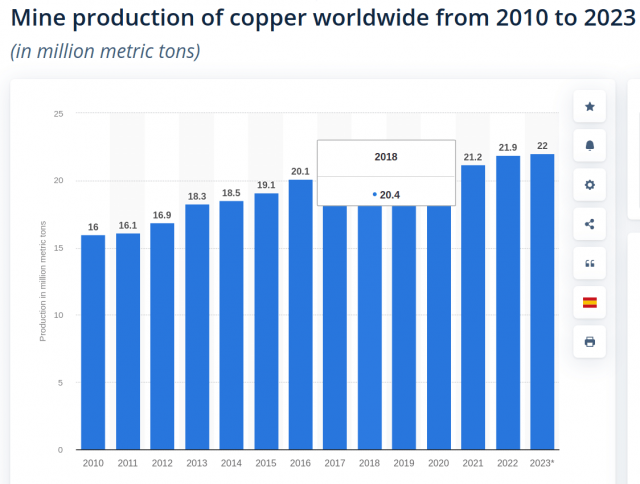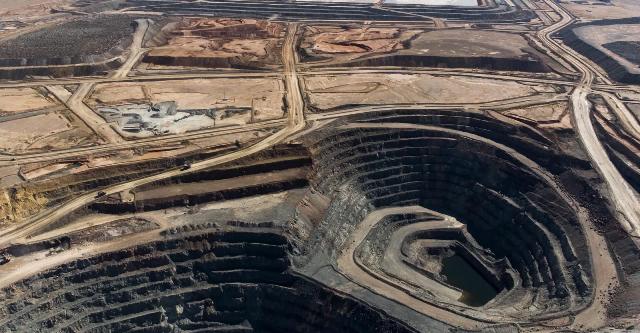Scientists from the United States have estimated that a fivefold increase in copper consumption during the transition to electric auto increases the need for this metal so seriously that a carbon-free transition is called into question even for some States. As an alternative, the authors of the scientific work proposed hybrids. From their point of view, no less problems are caused by the introduction of renewable energy sources, which also require a lot of copper. However, there are serious bottlenecks in the study.
Researchers from the University of Michigan and Cornell University (USA) published a paper on the website of the International Energy Forum [...] (the website of the University of Michigan also writes about it), which showed an increase in copper needs due to the carbon-free transition. In order to ensure a global transition to electric vehicles (in terms of sales of new cars), copper production must be increased by 55 percent relative to the level that would be needed without them. At the same time, the "transition to hybrids," the scientists noted, would require a "slight" increase in copper demand.
As a typical example of an increase in copper consumption, the authors of the study named the Honda Accord sedan, which is popular in the United States. Its internal combustion engine version needs only 18 kilograms of copper, and fully electric - already 90 kilograms. In addition, a major expansion will require the power grid to charge electric cars. Scientists have concluded that 40 percent of the output from all new copper mines in the world will have to be sent for electrification of electric vehicles.
Things are not much better with the electric power industry. A large offshore windmill with eight megawatts of capacity today requires about 10 tons of copper.
One of the researchers noted: "I am a big fan of the Law on Reducing Inflation (contrary to the name, this American law is about a carbon—free transition. — Ed.), I have solar panels, batteries at home and an electric car. I'm all for the energy transition. However, it must be carried out in a realistic way."
This is how the authors consider hybrid cars. Copper deficiency, from their point of view, is the limiting factor of the entire energy consumption.
Meanwhile, many of the theses of American scientists are in doubt. For example, they take as examples of copper consumption by electric vehicles models of manufacturers who do not make electric cars in large quantities at all (Honda), therefore they understand this process approximately at the level of AVTOVAZ. At the same time, more competent manufacturers require much less copper for their machines.
For example, in 2023, Tesla launched the world's first car with a 48-volt low-voltage on-board network and an 816-volt high-voltage on-board network (Cybertruck). The main role here is played by a low voltage network, since the main length of the wires in the machine is made precisely at low voltage. In addition, Cybertruck has one wire for all peripheral devices: if in a conventional car there are two separate wires to the door column and to the electric window lifter in the same door (and so to all consumers), then Cybertruck has one wire (threaded throughout the car) that serves all consumers, except for running electric motors.
A fourfold increase in voltage (today the on-board network of a conventional car operates at 12 volts) means a multiple of the lower need for copper for a low-voltage network. An 800 volt high-voltage grid also requires significantly less copper than the 400-volt ones that dominated electric vehicles in the 2010s. Therefore, the same Cybertruck needs half as much copper as an electric car of similar power in the 2010s.
In other words, the production of even 100 million electric vehicles per year would require not nine million tons of copper, as the authors of the new scientific work believe, but only less than 4.5 million tons. And this is assuming that the voltage in the on-board networks of future electric vehicles will not rise above the level of 2024, which is also not obvious.

It is easy to see that over the past dozen years, copper production has increased by even more than 25 percent. At the same time, the declines occurred not because of a shortage of copper ore, but because of a temporary drop in prices, that is, demand for copper
Image source: Statista
Windmills definitely require a lot of copper. But an eight-megawatt offshore windmill generates at least 25 million kilowatt hours per year. One million of these wind turbines will produce 25 trillion kilowatt hours (the total generation of the entire Earth today) and will require 10 million tons of copper. Obviously, a million wind turbines will not be built in one year: it will take decades.
But even if someone could achieve such a manufacturing feat in just 10 years, only a million tons of copper per year would be needed. Together with 4.5 million tons of copper per year for electric vehicles, we are talking about 5.5 million tons annually — only a quarter of the total production in 2023. Given that copper production was growing steadily even before the start of the energy transition, there is no unsolvable problem in the increase by another 25 percent.
Scientists' calculations regarding the need for copper to expand the power grid are highly questionable. Indeed, the transition to electric cars needs refueling, and those need wires. But it is worth remembering that the wires for power lines in the world are almost all aluminum, because they are cheaper and lighter than copper. In cars and wind farms, copper is preferable, since it bends easier and is more convenient for dense layouts, but these requirements do not apply to power lines.
Of course, this does not mean that electric vehicles or wind farms do not have other difficulties. For example, electric cars, as Naked Science wrote, will not cost less than tens of thousands of dollars today, that is, budget cars with internal combustion engines are still significantly cheaper. Things are even worse with wind farms: they, like SES, cannot provide a carbon-free transition in principle, for purely technical reasons.

